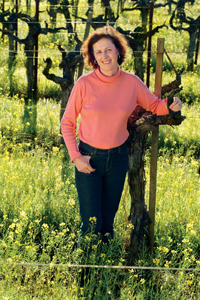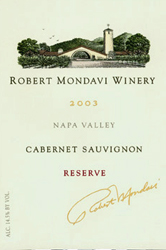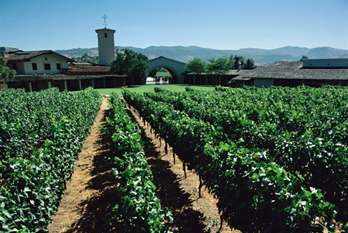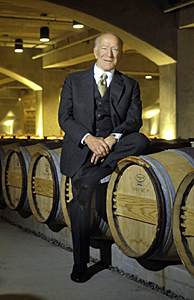

Genevieve Janssens has been director of winemaking at Robert Mondavi Winery since 1997.
How Robert Mondavi Winery
Maintains Its Original Vision
You get Genevieve Janssens as the winemaker.
Three years under Constellation Brands, unheralded Genevieve Janssens still makes classic Mondavi wines – maybe even better. And Constellation Brands hands-off policy is paying off.
by
Alan Goldfarb
February 1, 2008
 n the final years of the Robert Mondavi Winery’s reign as the U.S.’s most iconic wine family, there was Genevieve Janssens, quietly making Bordeaux-like classic American wine. In the aftermath of the three years since the Mondavis lost their Napa Valley property, there still stands Genevieve Janssens, now making those classic red wines for the world’s largest wine corporation.
n the final years of the Robert Mondavi Winery’s reign as the U.S.’s most iconic wine family, there was Genevieve Janssens, quietly making Bordeaux-like classic American wine. In the aftermath of the three years since the Mondavis lost their Napa Valley property, there still stands Genevieve Janssens, now making those classic red wines for the world’s largest wine corporation.
 Always eclipsed by the large visages of Robert Mondavi himself, and his sons Michael and Tim, the Moroccan-born, French-raised Janssens has been nearly unheralded in her endeavors.
Always eclipsed by the large visages of Robert Mondavi himself, and his sons Michael and Tim, the Moroccan-born, French-raised Janssens has been nearly unheralded in her endeavors.
The scintillating missteps that the Mondavi family may or may not have taken as they attempted to play with the big money boys on The Street served to spin the perception in the marketplace as to the quality of their wines. Three years out, the winery continues apace. Now, under the aegis of the enormous maw that is Constellation Brands, RMW is trying to stay ahead of the peloton as it attempts to reconstitute the ashes and salve the bruises that the former company sustained in the scrum that led to the takeover.
All the while, however, there was - and is - Genevieve Janssens, Mondavi’s dedicated and talented director of winemaking since 1997. During a recent private tasting held exclusively for me in a glass-enclosed, mahogany-lined chamber off the barrel room, Janssens proved that the Robert Mondavi Winery lives.
More important, if the quality of the wines I tasted that afternoon is an indication, Janssens and her longtime winemaking team are making the same wonderfully balanced Napa Valley wines that she has created for the namesake patriarch since 1997.
If anything is different since Constellation took control in December, 2004, it is that the wines may even be better; and, as one might expect, the steady infusion of capital in the 38 months of CB’s short reign helps - a lot.
While Janssen’s wines may not capture the full attention of some critics whose palates crave decidedly more showy wines, to my taste, they are one of the best groups of wines from the Napa Valley that I’ve tasted in a while. They are balanced with perfectly ripened fruit; possess tamed but age-worthy tannins; and have alcohol levels that are melded into the wine - although they were a higher percentage than I believed.
During the tasting, the soft-spoken but intensely passionate Janssens quietly but forcefully rails at the inanimate but ubiquitous stained wood in the room, a factor that may or may not have played

The Oakville estate vineyards surround the Robert Mondavi Winery, which has not altered its 350,000 case production since Constellation Brands took over.
After re-pouring the first three wines she shrugs her shoulders in frustration and declares. while dragging her fingers violently over her left arm, which momentarily leaves a white impression where the blood had been, “You don’t know how depressing it is (to not have an optimal tasting environment), it’s like stripping a piece of my skin off.”
Don't Change A Thing
Janssens says that production levels - 350,000 cases produced in Oakville - haven’t deviated since Constellation took over; and she knows of no long-range plans to change that number. “We’re cruising; and it helps us to focus on the wines,” she says.There have been inroads into vineyard and winery research and new clones and rootstocks have been implemented. Zinfandel blocks have been torn out. Rich Arnold, who has been with the company for 32 years and has been the associate winemaker in charge of white wines since 1998, calls the culture since CB bought the entire Mondavi stable for $1.3 billion, “an evolution, not a change.”
Janssens doesn’t hesitate to reveal that CB has infused the company with more money, while disclosing that at the end of the Mondavi regime, “It was more difficult to get funds.” CB’s money is being used chiefly to replant the gem in the deal, the storied To Kalon Vineyard that is on the property. She says that within 10 years, the 550 acres will be completely redone.
Janssens also talked about how Constellation has left her to her own devices and let her remain autonomous in her winemaking choices.
“Icon (CB’s fine wine division) and Constellation Brands leaves us completely to ourselves,” she insists “(Meetings with them) are not even on the books. … They leave us completely free and I think that’s good. I feel very good about that. There’s a trust and a belief in the winery.”
But does the consumer and the retail market - and to a lesser extent, the critics - still believe in what was once the country’s most famous winery?
“The market is better now that we have two different brands,” Janssens acknowledges, referring to the higher-end RMW Oakville brand and the lower-end Lodi Woodbridge. Although she says, jokingly, “I forgot the other name.”
The co-mingling of the two brands was a most important factor as to why Mondavi lost some of its once brilliant luster. Janssens’ red wine maker Gustavo Gonzalez, who has been at the company since ’78, admits that having two disparate brands, which was perceived as being under one roof, made it “very confusing for high-end specialists (sales people) to sell a $5 wine (Woodbridge) and a $100 wine (Mondavi’s Oakville reserves). We run out of wine now and in the past we didn’t.”
Mondavi: “We have lost our image.”
It was precisely what Robert Mondavi himself was talking about when asked by this reporter in December of 2002 about the state of his floundering company. It was because the strategy was to go
Robert Mondavi in the barrel room of his eponymous winery before it was sold to Constellation Brands.
Nonetheless, Janssens - who was the director of production for the Mondavi-Rothschild joint venture, Opus One, from 1989-96 - talked lovingly about what Robert Mondavi had imparted in her. She discu










 READER FEEDBACK: To post your comments on this story,
READER FEEDBACK: To post your comments on this story,



